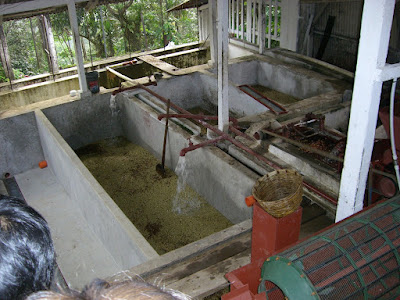 Our week-long trip to Oaxaca, Mexico was a welcome respite from life in Quetzaltenango, despite my fondness for our adopted city here in Guatemala. Oaxaca had all the historical and architectural appeal of Guatemala's beautiful Antigua, but with a much cleaner, livelier façade. Oaxaca is more than twice Quetzaltenango's size and "el centro" was buzzing with both tourists and locals the entire time we were there. The streets were clean and the air clear and fresh - there were no buses belching out black smoke like there are in Xela. This first picture shows a small area of a street out front of Santo Domingo, a large church in the "centro" area.
Our week-long trip to Oaxaca, Mexico was a welcome respite from life in Quetzaltenango, despite my fondness for our adopted city here in Guatemala. Oaxaca had all the historical and architectural appeal of Guatemala's beautiful Antigua, but with a much cleaner, livelier façade. Oaxaca is more than twice Quetzaltenango's size and "el centro" was buzzing with both tourists and locals the entire time we were there. The streets were clean and the air clear and fresh - there were no buses belching out black smoke like there are in Xela. This first picture shows a small area of a street out front of Santo Domingo, a large church in the "centro" area. This picture shows Kira, Greg, and me in our Day of the Dead masks that we made with plaster at the Instituto Cultural where we studied Spanish all week. The Centro Cultural was beautiful, and we learned a lot about the differences in expression between Mexican and Guatemalan Spanish. We also used our masks in a small Day of the Dead parade organized by the Instituto, carving a large rectangular route out of the surrounding neighborhood with our procession of musicians, giant dancing figurines, and dozens of masked participants.
This picture shows Kira, Greg, and me in our Day of the Dead masks that we made with plaster at the Instituto Cultural where we studied Spanish all week. The Centro Cultural was beautiful, and we learned a lot about the differences in expression between Mexican and Guatemalan Spanish. We also used our masks in a small Day of the Dead parade organized by the Instituto, carving a large rectangular route out of the surrounding neighborhood with our procession of musicians, giant dancing figurines, and dozens of masked participants. The night of October 31st we visited three different cemeteries in Oaxaca to mark the Day of the Dead. The cemeteries were filled with people in a festive vigil atmosphere, each tomb surrounded by family and covered with candles and the traditional Day of the Dead flowers. The surrounding streets were thronged with people, vendors, carnival games and rides, and the also very traditional sand portraits (click on the album link on the right-hand side of the page to check out a lot more photos). Overall it was an incredible atmosphere and I, for one, was impressed by the beautiful traditions that I was experiencing for the first time; traditions unknown in the US.
The night of October 31st we visited three different cemeteries in Oaxaca to mark the Day of the Dead. The cemeteries were filled with people in a festive vigil atmosphere, each tomb surrounded by family and covered with candles and the traditional Day of the Dead flowers. The surrounding streets were thronged with people, vendors, carnival games and rides, and the also very traditional sand portraits (click on the album link on the right-hand side of the page to check out a lot more photos). Overall it was an incredible atmosphere and I, for one, was impressed by the beautiful traditions that I was experiencing for the first time; traditions unknown in the US.

I think it was our second day in Oaxaca when we went to visit the Zapoteca ruins at Monte Alban. The impressive ruins date back to around 800B.C. We spent a few hours there being led around by a redundant tour guide who had the habit of describing something in Spanish and then reiterating the easiest of cognates in English (like "destrucción" to "destruction"), exacerbating an already tedious process. The ruins themselves were emormous and extremely impressive, and more pictures are again in my albums on Picasa (click the link on the right).
Overall, Oaxaca was amazing, and since the US dollar is worth about 12.5 Pesos, I recommend that everyone eventually visit there. At touristy spots the people usually even speak enough English that you could get by :-). I definitely plan to go back one day.
















































